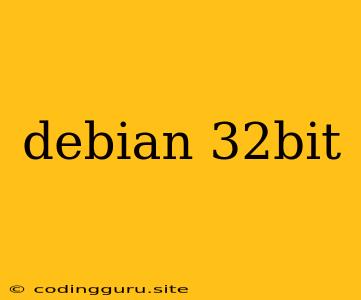Navigating the World of 32-bit Debian: A Comprehensive Guide
Debian, known for its stability and vast package repository, offers a 32-bit version, catering to specific hardware and legacy applications. While 64-bit systems dominate the modern landscape, there are scenarios where 32-bit Debian is the preferred choice.
Why Choose 32-bit Debian?
- Legacy Hardware: If you have an older computer with a 32-bit processor, a 32-bit Debian installation is your only option for running a modern operating system.
- Specific Applications: Some applications, particularly older ones, may only be available as 32-bit binaries.
- Resource Constraints: 32-bit systems require less RAM and have smaller footprints, making them suitable for low-resource devices.
Finding and Installing 32-bit Debian
- The Debian Website: Begin your journey by visiting the official Debian website. Navigate to their download section, where you'll find the latest stable release of 32-bit Debian.
- Mirror Selection: Choose a mirror closest to your location for faster download speeds.
- Download the ISO: The downloaded ISO image contains the entire operating system. You'll need to burn it to a bootable USB drive or DVD.
Installation Process
The installation process for 32-bit Debian is quite similar to the 64-bit version. Here's a general outline:
- Boot from the USB Drive: Boot your computer from the bootable USB drive.
- Select Installation Options: Choose the "Install" option from the Debian installer menu.
- Choose Language: Select your preferred language.
- Network Configuration: Connect to the internet if available. This step is crucial for downloading essential packages during installation.
- Disk Partitioning: Choose a partitioning method for your hard drive. The installer can automatically handle this, but if you have specific needs, manual partitioning is also an option.
- User Creation: Create your user account with a username and password.
- Installation: The installation process will download and install the necessary packages. This may take some time depending on your internet connection and system specifications.
- Reboot: Once the installation is complete, reboot your system and enjoy your new 32-bit Debian environment.
Post-Installation
After installing 32-bit Debian, there are a few essential steps to take:
- Software Updates: Update your system with the latest packages using the
apt updateandapt upgradecommands in the terminal. - Install Essential Applications: Install common applications like a web browser, text editor, and a terminal emulator.
- Customize your Desktop: You can customize your desktop environment by installing themes, icons, and other visual enhancements.
Troubleshooting
- Network Connectivity: If you have network issues, make sure your network configuration is correct and your internet connection is working.
- Driver Issues: Some hardware may require specific drivers. You can install these drivers through the Debian package manager or by searching for them on the internet.
- Compatibility: If you encounter compatibility issues with certain software, check if it has a 32-bit version available. If not, consider using an alternative application or running the software in a virtual machine.
Alternatives to 32-bit Debian
- 32-bit Linux Distributions: Other Linux distributions such as Ubuntu and Fedora also offer 32-bit versions.
- Virtual Machines: If you need to run 32-bit applications on a 64-bit system, you can use a virtual machine like VirtualBox or VMware.
Conclusion
While 32-bit Debian might seem outdated in the era of 64-bit dominance, it still serves as a valuable option for specific needs. By understanding its uses, navigating the installation process, and addressing potential troubleshooting scenarios, you can leverage the power and stability of 32-bit Debian in your computing environment.
